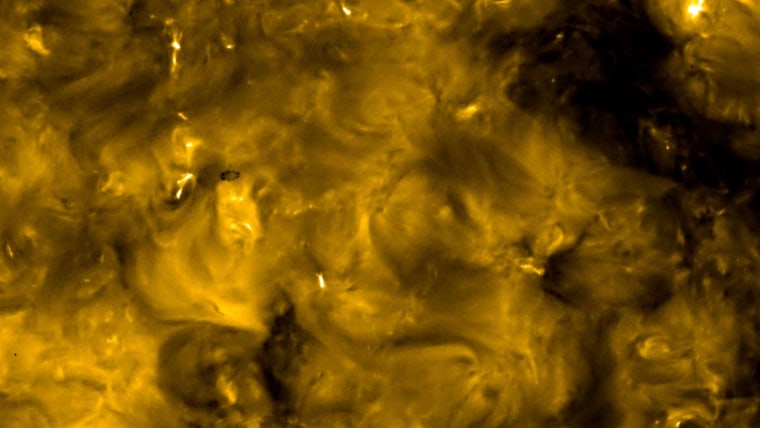A 'dent' in Earth's magnetic field puzzles scientists



Scientists are keeping a close eye on a growing "dent" in Earth's magnetic field over a swath of the Atlantic Ocean that stretches from South Africa westward into Brazil.
In this zone, known as the South Atlantic Anomaly, the magnetic field — the invisible shield that protects the planet from radiation and charged particles from the sun — is weaker than normal. Though it's not thought to be dangerous to humans, experts say the weak spot could cause glitches or permanent damage to Earth-circling satellites that are exposed to energetic particles as they fly through the region.
"Those particles can wreak havoc on satellite instrumentation, so it's good to track the South Atlantic Anomaly, and especially its changing shape, so that we can take preventative actions," Terence Sabaka, a geophysicist at NASA's Goddard Space Flight Center in Greenbelt, Maryland, said.
Scientists have known about the weak spot in Earth's magnetic field for several decades, but new research suggests that the South Atlantic Anomaly is growing, spreading further west toward the Pacific Ocean, and is further weakening.
"Satellite measurements, as well as theoretical modeling, predict that the area will be larger in the next five years or longer, and the strength of the magnetic field in that area will be even lower," Weijia Kuang, a geophysicist and mathematician at NASA Goddard's Geodesy and Geophysics Laboratory, said.

Closest images of the sun ever taken released by NASA, European Space Agency
Kuang added that the weak spot also appears to be splitting in two, though it's not yet known what specifically is driving that process.
Earth's magnetic field is generated by the constant motion of liquid metal in the planet's iron-rich outer core, roughly 1,800 miles below the surface. As these molten deposits slosh around, they produce electric currents that power Earth's magnetic field and effectively turn the planet into a giant bar magnet.
But the constant churning in the outer core means the magnetic field is tilted, which is why the magnetic poles aren't perfectly aligned with Earth's geographic North and South poles. These dynamics deep inside the planet also create fluctuations and instability in the magnetic field.
In general, the magnetic field is strongest at the poles and weaker at the equator, but more research is needed to understand the precise cause of the South Atlantic Anomaly.
"It's like a weakness on top of a weakness," Sabaka said, adding that although other spots exist where the magnetic field is less intense, the one over the Atlantic is by far the largest and most significant.
Sabaka and Kuang have been mapping the South Atlantic Anomaly, but more data will help them finesse their models and build more accurate forecasts of how the weak spot could change over time.
Kuang said these insights will not only help protect satellites and other spacecraft in orbit around Earth, but could also give scientists a better understanding of processes that have unfolded deep inside the planet over hundreds of thousands or millions of years.



Interesting article. Thank you.
I knew that the magnetic poles change due to the fluid condition of Earth's iron core. To consider a weakness in the magnetic field is something new.
I was wondering if this "dent" might be a first step towards an inversion, but the article didn't mention the possibility.
If not a first step, at least a symptom of an upcoming one.
Magnetic North has been changing it's position at a greater rate the past few years. That could be another sign of a coming inversion.
Inversions have happened before, so I would not be surprised if that is what is where we are heading.
True. I saw a map the other day, of how fast the magnetic north pole is moving. We'll soon need slow-motion compasses...
Last year alone it moved 50 nautical miles.
Excellent!
Crazy stuff.
Fun science, and stuff we need to learn more about till we understand it in detail.
In doing a search I came across this article..... It seems to fit with the topic so as not to derail
I absolutely agree. The question is... will Michigan become a warm state. I'm sure that's not really the case but one can dream.
I'm sure that's not really the case but one can dream.
All kidding aside though, like Perrie stated, the poles have inverted before. I think that things that have happened to the earth in the past are quite likely to occur at some point again. We need to figure out how to determine said timeline for these (often massive) events.
If a flip does start taking place, we better learn to navigate by the stars again for a while!
Could it be that this anomaly has always been there, we're just now able to measure it. The anomaly may only be an eddy in the flow of the molten metal caused by the only major disruptions in the southern hemisphere, Africa and South America acting like dams, the very weight of the continents might be protruding inwards as much as they do outwards.
They're negligeable, I think. They're like foamy scum on a pond - not affecting the water's flow at all.
I'd say we've had sensitive enough instrumentation to measure this phenomena for decades. Given we are dealing with an iron core that is fluid, and that inversions have been proven, I'd say it is just an aberration in the magnetic field generated by the earth. Good stuff though.
That's right "decades" 2-9 ago, satellites 7 ago, our interest in measuring maybe 5-6 ago not really enough time to determine long range what it means or how long it's been happening. Being that the anomaly is between two continents and not in the middle of the pacific ocean, then maybe it has something to do with the continents.